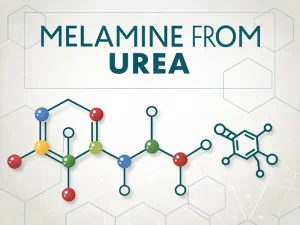
Melamine Packaging
Tech Blog Melamine packaging For manufacturers, inaccurate packaging not only fails to meet national standards but also increases labor costs and the risk of product

Melamine formaldehyde (MF) resin is a high-performance thermosetting polymer known for its excellent heat resistance, durability, and chemical stability. From flame-retardant laminates to food-grade tableware, their wide application stems from the unique molecular structure formed by the precise reaction of melamine and formaldehyde.
Understanding the structure of melamine formaldehyde is key to optimizing its performance, solving production problems, and expanding its application in advanced materials.
Melamine formaldehyde resin is a synthetic polymer formed by the reaction of melamine (a nitrogen-rich triazine compound with the molecular formula C₃H₆N₆) and formaldehyde (a simple aldehyde with the molecular formula CH₂O). As an amino resin, it differs from other polymers, such as urea-formaldehyde (UF) resin, in its higher crosslinking density and superior thermal stability, both of which are directly related to its unique molecular structure.
The core value of melamine formaldehyde resin lies in its rigid, three-dimensional, crosslinked network that forms during curing and is irreversible. Once set, it cannot melt or reshape even at high temperatures, making it very suitable for high-temperature and high-stress applications.
The structure formation of melamine formaldehyde resin is divided into two main stages, each of which plays a decisive role in the final performance: hydroxymethylation (generating reactive intermediates) and condensation/crosslinking (forming a three-dimensional network).
The first stage is carried out under alkaline conditions (pH 8-10, usually adjusted with ammonia or sodium hydroxide) and medium temperature (60-80 ℃). At this point, melamine reacts with formaldehyde to form hydroxymethylated melamine – that is, one or more hydroxymethyl (-CH₂OH) groups are attached to the amino group (-NH₂) of melamine molecules.
Depending on reaction conditions, multiple formaldehyde molecules can be linked to the same melamine ring, forming dihydroxymethyl melamine, trihydroxymethyl melamine, tetrahydroxymethyl melamine, pentahydroxymethyl melamine, and even hexahydroxymethyl melamine. These molecules are still relatively small and typically exist as liquid resin at this stage.
This is a crucial step in materials gaining strength. Hydroxymethylmelamine molecules begin to react with each other. When hydroxymethyl (-CH₂OH) in one molecule reacts with amino (-NH₂) in another molecule, they release a water molecule (H₂O) and form a strong methylene bridge (-CH₂-) between two melamine rings.
This process is called a condensation reaction because it releases water molecules, but it does not proceed in a straight line. Due to the multiple reaction sites of each melamine molecule, it can form bridges in various directions. This forms an extensive, three-dimensional, highly crosslinked network.
Thanks to the six reaction sites of melamine (compared to only two for urea in urea formaldehyde resin), the crosslinking density of melamine formaldehyde resin is much higher than that of urea formaldehyde resin. This dense network:
Improve heat resistance (melamine formaldehyde resin can remain stable at 200-250 ℃, far exceeding the tolerance limit of urea formaldehyde resin);
Enhance hardness and rigidity (crucial for molded products such as electrical insulators);
Improve chemical resistance (resist acid, alkali, and solvent erosion).
The triazine ring of melamine (a six-membered ring containing three nitrogen atoms) is rigid and thermally stable. This aromatic structure:
Granting melamine formaldehyde resin flame retardancy (releasing nitrogen gas during combustion, suffocating flames);
Enhance mechanical strength (the ring structure can resist stress deformation).
Methylene bridges form more readily at higher curing temperatures (100-140 ℃) and are the primary source of heat and chemical resistance in melamine-formaldehyde resins.
Ether bridges generate more at lower curing temperatures (80-100 ℃) and are prone to hydrolysis (decomposition in humid environments), which may reduce long-term stability.
In production, by optimizing the curing conditions, priority is given to forming methylene bridges to meet high-performance requirements.
Trace amounts of unreacted formaldehyde, melamine, or hydroxymethyl may remain in the cured resin. These functional groups:
May cause a small amount of formaldehyde release (much lower than urea-formaldehyde resin), making melamine formaldehyde resin more suitable for indoor use.
Slightly reduced water resistance (unreacted hydroxymethyl groups tend to adsorb moisture).
Modern production processes, such as precise control of the melamine-to-formaldehyde ratio, can minimize these residual groups to the greatest extent possible.
The ratio of the two directly affects the crosslinking density:
High formaldehyde ratio: promotes hydroxymethylation and crosslinking, improves density and heat resistance, and is suitable for high-performance products such as flame-retardant coatings.
Lower formaldehyde ratio: reduces crosslinking density, enhances flexibility, and is suitable for adhesives or coatings that require a certain degree of elasticity.
Alkaline conditions (8-10): Ensure controlled hydroxymethylation and avoid premature crosslinking in the first stage;
Acidic conditions (4-6) trigger the second-stage crosslinking. If the pH is too low, it will lead to rapid amation formation, making it brittle and prone to loosening.
Temperature: Higher temperatures (120-140 ℃) accelerate crosslinking and promote the formation of methylene bridges, enhancing stability; Lower temperatures (80-100 ℃) slow down curing and increase the proportion of ether bridges.
Time: Extending the curing time at the optimal temperature can ensure complete crosslinking, reduce unreacted groups, and improve structural uniformity.
The structure of melamine formaldehyde resin enables it to withstand the high demands of industrial applications.
High cross-linkcrosslinking density and methylene bridges confer a hard, scratch-resistant surface. Melamine formaldehyde resin bonds paper or fabric layers into laminated boards (such as kitchen countertops), which can withstand high temperatures, stains, and moisture – very suitable for high-frequency use environments.
The rigid triazine ring skeleton and dense crosslinking make melamine formaldehyde resin suitable for molding products. Food-grade melamine tableware can withstand hot liquids and repeated cleaning, while electrical components (switches, connectors) utilize their insulation and heat resistance.
When the triazine ring burns, it releases nitrogen gas, which can suppress flames. This structural characteristic makes melamine formaldehyde resin a key flame-retardant component in textiles, insulation materials, and building materials, including aircraft interiors.
The moderate crosslinking density imparted by the lower formaldehyde ratio makes the resin flexible. It can be used as an adhesive for wood or metal (with better water resistance than urea-formaldehyde resin). Coatings use their chemical resistance to protect metals from corrosion.
The structure of melamine formaldehyde—a dense, three-dimensional network formed by triazine rings connected by methylene and ether bridges—is the core of its high-performance polymer. This structure is the fundamental secret behind the durability, heat resistance, and long lifespan of countless products we use in our daily lives.
Understanding the correlation between structure and performance helps develop more sustainable and highly stable materials. With the increasing demand for safer, more durable solutions in the industry, optimizing the structure of melamine formaldehyde will continue to support its essential role in the industrial sector.

Tech Blog Melamine packaging For manufacturers, inaccurate packaging not only fails to meet national standards but also increases labor costs and the risk of product

Tech Blog How to Detect Melamine in Textiles? Melamine powder, a nitrogen-containing heterocyclic compound, is widely used in flame-retardant textiles and plastic products due to

Tech Blog melamine from urea Melamine is well-known for its wide range of applications, but its raw material for production is surprisingly urea. For manufacturers,

JINGJIANG MELAMINE POWDER
© JINJIANG MELAMINE